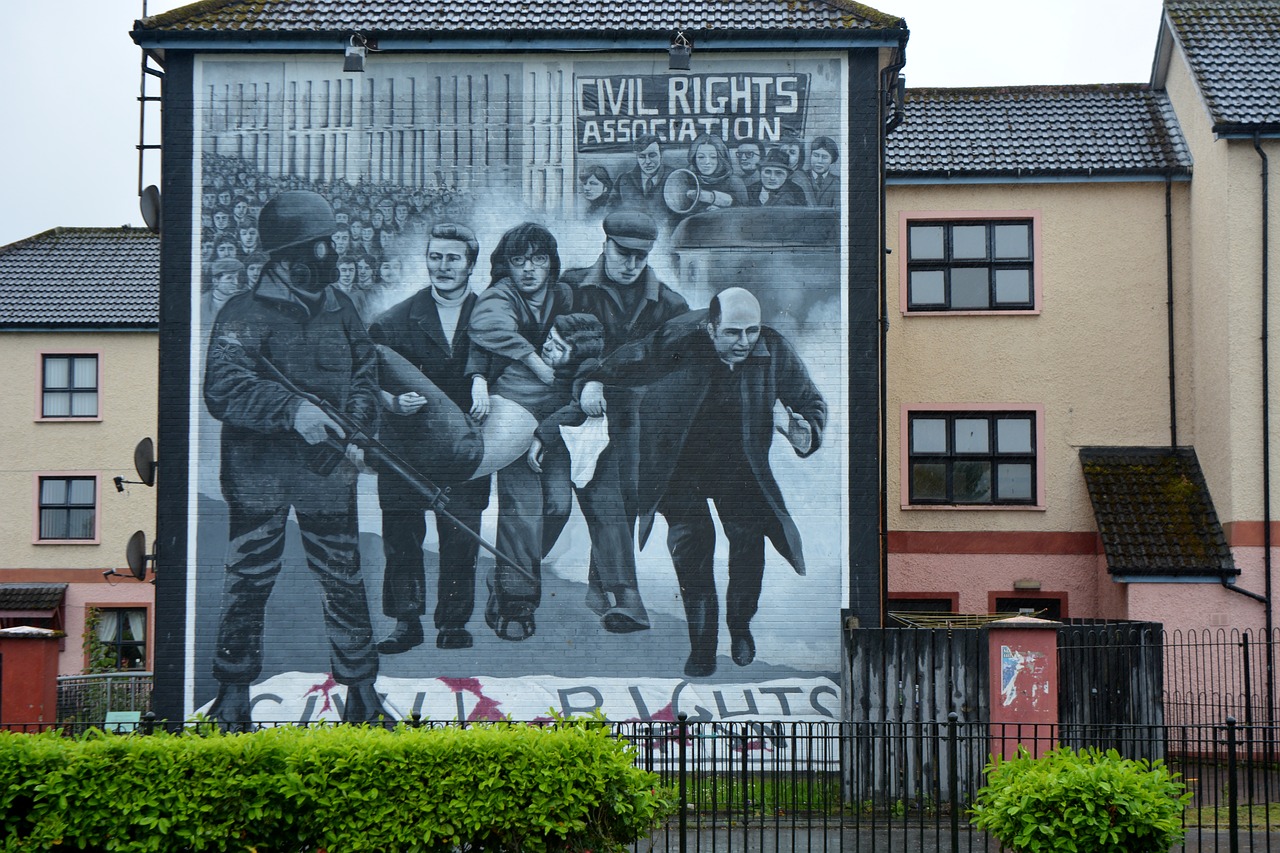
by DGR News Service | Jul 23, 2019 | Direct Action, Education, Strategy & Analysis
Editor’s note: this article contains extensive excerpts from the Irish Republican Army’s Green Book, one of their key training documents during their 20th-century struggle against British occupation.
Written by Liam Campbell
“Don’t be seen in public marches, demonstrations or protests. Don’t be seen in the company of known Republicans, don’t frequent known Republican houses. Your prime duty is to remain unknown to the enemy forces and the public at large.”
Like all successful underground organisations, the Irish Republican Army maintained a strict firewall between their aboveground and underground movements, this ensured that publicly identifiable individuals could not be pressured into revealing underground militants, providing a certain level of safety for both groups. The Irish Republican Army also emphasized the importance of abstaining from alcohol or other drugs, which they identified as the single greatest threat to any guerilla organisation.
“Many in the past have joined the Army out of romantic notions, or sheer adventure, but when captured and jailed they had after-thoughts about their allegiance to the Army. They realised at too late a stage that they had no real interest in being volunteers. This causes splits and dissension inside prisons and divided families and neighbours outside.”
When recruiting, the Irish Republican Army recognised that successful underground members had certain characteristics; they were intelligent, reliable, and they were capable of giving their total allegiance to the cause. These characteristics ensured that they would consistently obey often difficult orders from the chain of command, regardless of the personal cost, and despite any personal issues they may have with their superior officers. Certain qualities could disqualify a person as a candidate: emotionalism, sensationalism, and adventurism were among them.
“The enemy, generally speaking, are all those opposed to our short-term or long-term objectives. But having said that, we must realise that all our enemies are not the same and therefore there is no common cure for their enmity. The conclusion then is that we must categorise and then suggest cures for each category. Some examples: We have enemies through ignorance, through our own fault or default and of course the main enemy is the establishment.”
One of the most essential features of the Green Book was the precision with which it defined enemies. You cannot wage a successful war if your targets are poorly defined. The Irish Republican Army identified three categories of enemy:
Enemies through ignorance are those individuals who can be cured through education. Tactics included marches, demonstrations, wall slogans, press statements, publications, and person-to-person communication. The Green Book stressed that self education was essential, which included ideological understanding and also tactical knowledge about how to organise large groups of people and how to successfully execute different actions.
Enemies through our own fault are the ones created by the Irish Republican Army’s actions, which includes personal conduct and the collective conduct of the movement. These enemies vary greatly. The elderly woman whose door was pulled off its hinges by an IRA member evading capture who doesn’t receive an immediate apology and recompense, the family and friends of an informer who has been punished without their being notified of the reason, and also the collateral victims of violence.
Members of the establishment who consciously take actions to maintain the status quo in politics, media, policing, and business. Although some of these enemies are clearly identifiable, most of them operate with various degrees of anonymity as bureaucratic cogs in a vast machine of oppression; this means that one of the greatest challenges is accurately identifying establishment members. Surprisingly, execution is not always the best way to make a member of the establishment ineffective, often it is better to expose them as liars, hypocrites, collaborators, or subjects of public ridicule.
“Many figures of speech have been used to describe Guerrilla Warfare, one of the most apt being ‘The War of the Flea’ which conjured up the image of a flea harrying a creature of by comparison elephantine size into fleeing (forgive the pun). Thus it is with a Guerrilla Army such as the I.R.A. which employs hit and run tactics against the Brits while at the same time striking at the soft economic underbelly of the enemy, not with the hope of physically driving them into the sea but nevertheless expecting to effect their withdrawal by an effective campaign of continuing harassment contained in a fivefold guerrilla strategy.”
The Irish Republican Army’s strategy included a war of attrition, the destruction of high-value assets, to make large regions ungovernable, to sustain a propaganda campaign, and to protect the movement against criminals, collaborators, and informers. The Green Book emphasized that volunteers need to achieve more than just killing enemy personnel, they must also create and maintain support systems that would not only carry the movement through the war, but would also facilitate a smooth transition after military victory had been achieved.
“Most volunteers are arrested on or as a result of a military operation. This causes an initial shock resulting in tension and anxiety. All volunteers feel that they have failed, resulting in a deep sense of disappointment. The police are aware of this feeling of disappointment and act upon this weakness by insults such as “you did not do very well: you are only an amateur: you are only second-class or worse”. While being arrested the police use heavy-handed `shock` tactics in order to frighten the prisoner and break down his resistance. The prisoner is usually dragged along the road to the waiting police wagon, flung into it, followed by the arresting personnel, e.g., police or Army. On the journey to the detention centre the prisoner is kicked, punched and the insults start. On arrival he is dragged from the police wagon through a gauntlet of kicks, punches and insults and flung into a cell.”
Capture was one of the greatest fears that volunteers lived with on a daily basis, so the Green Book addressed these concerns in detail and prepared volunteers for that possibility. This section was broken down into the actual arrest, the interrogation, and the legal process. There were three categories of torture that volunteers could face: physical, subtle psychological, and humiliation. Physical torture often took the form of beatings, kicking, punching, and cigarette burns. Psychological torture could include threats to family, friends, and self, or threats of assassination and disfigurement. Humiliation included being stripped naked, remarks about the prisoner’s sexual organs, and removing symbolic defense mechanisms.
One of the ways the Green Book prepared volunteers was by reminding them that they could only be held and tortured for a maximum of 7 days. Although the experience would likely be horrific, it could only last for a relatively brief duration; if they confessed or capitulated during their interrogation they could easily face a lifetime in prison where they would experience much of the same torture. One of the coping strategies they employed was to form images in their minds or on the surrounding walls, directing their concentration away from the interrogators and diverting it toward positive or neutral ideas, even something as simple as a flickering candle or a leaf.
Overall, what the Green Book does is it clearly lays out the ideological foundations of the movement, the requirements of its volunteers, the methodology for identifying and categorising enemies, the tactics that should be employed, and it also addresses the greatest fears of volunteers and teaches them how to cope in the event that they must face them. These are the foundational psychological requirements that are needed to recruit and retain effective underground guerillas. They must know why they are taking action, what their actions will achieve, how to behave, who they are targeting, and they need to know that they will be able to overcome their fears should they need to face them.
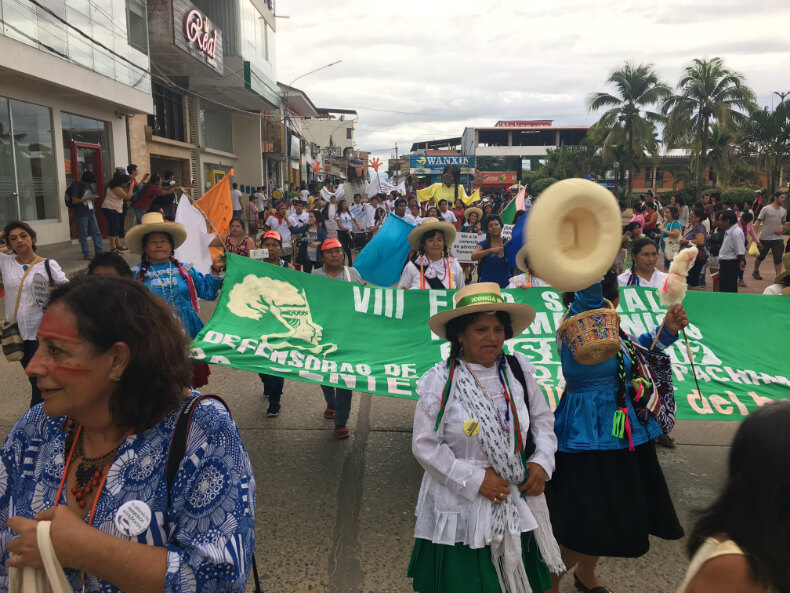
by Deep Green Resistance News Service | May 12, 2017 | Education, Indigenous Autonomy
Featured image: Indigenous women carry the banner of the VIII Pan Amazonian Social Forum (FOSPA) during the opening march from downtown Tarapoto to Universidad San Martin on April 28. Photo: Manuela Picq
by Manuela Picq / Intercontinental Cry
Ever since European colonial powers started disputing borders on its rivers in the seventeenth century, the vast Amazon rainforest—known simply as Amazonia—has been under siege.
Amazon Peoples always resisted the colonial invasion, even after the borders were ultimately settled with the Amazon rainforest getting divided into the territories of nine states. They’ve had no choice. After all, the insatiable lust for ‘wealth at any cost’ did not lessen with time; the siege continued through the nineteenth century, in part with the rubber boom that gave way to the automobile boom.
The attack rages on even now, with the intensive push to extract everything the Amazon holds including oil, minerals, water, and land for agriculture and soy production.
Nations states are leading the land-grab, fostering environmental conflicts that kill nature defenders (most of them indigenous), displace communities, and destroy rivers for megaprojects. The organization Pastoral da Terra estimates that half a million people are directly affected by territorial conflicts in the Brazilian Amazon. About 90% of Brazilian land conflicts happen in Amazonia; 70% of murders in land conflicts take Amazon lives.
That is why people responded to “the call from the forest,” or “el llamado del bosque” in Spanish. This was the motto of the VIII Pan-Amazonian Social Forum, or Foro Social Pan Amazónico (FOSPA), that just gathered 1500 people in the town of Tarapoto, Peru.
The VIII Pan Amazonian Social Forum in Tarapoto, Peru

Photo: Manuela Picq
FOSPA is a regional chapter of the well-established World Social Forum. It is based on the same model that brings together social movements, associations and individuals to find alternatives to global capitalism. From April 28 to May 1, indigenous peoples, activists, and scholars from various parts of Amazonia got together in the campus of Universidad Nacional San Martin.
FOSPA is an important space, not only because the region is at the forefront of the climate crisis but also because it represents 40% of South America and spreads across nine countries—Brazil, Bolivia, Peru, Ecuador, Colombia, Venezuela, Guyana, Suriname, and French Guyana. The 370 indigenous nations in the region are an increasingly smaller part of a booming Amazon population that surpasses 33 million.
This VIII forum was well organized in an Amazon campus with comfortable work space and the shade of mango trees. In the absence of Wi-Fi, participants gathered around fruit juices and Amazon specialties baked in banana leaves at the food fair. The organizing committee, led by Romulo Torres, was most proud of creating the new model of pre-forum. For the first time, there were 11 pre-forums organized in 6 of the 9 Amazon countries to prepare the agendas.
The forum started with a celebratory march through Tarapoto. During three days, participants discussed the challenges of extractive development and land grab across the region. There was in total nine working groups organized around issues such as territoriality, megaprojects, climate change, food sovereignty, cities, education and communication.

During the opening march in defense of Amazonia, Elvira and Domingo, from Ecuador’s Confederation of Indigenous Nationalities of the Amazon (Confeniae) walk along Carlos Perez Guartambel, from the Andean Network of Indigenous Organizations (CAOI) and Ecuador’s Confederation of Kichwa Peoples (Ecuarunari). Photo: Manuela Picq
“Development is the problem”
Speakers strongly criticized models of development based on extractive industries. “Development is the problem, not the solution,” said Carlos Pérez Guartambel, from the Andean Network of Indigenous Organizations (CAOI) and the Confederation of Kichwa Peoples of Ecuador (ECUARUNARI).
Speakers blamed the political left for being equally invested as the right in extractive development, destroying life in the name of development. Toribia Lero Quishpe, from the CAOI and the Council of Ayllus Markas of the Quillasuyu (CONAMAQ) argued that this investment in capitalist gains corrupted the government of Evo Morales, who licensed over 500 rivers to multinational companies.
Gregorio Mirabal, from the Indigenous Network of the Amazon River Valley (COICA) and Venezuela’s Organization of Indigenous Peoples of the Amazon (ORPIA) denounced a massive land grab by the state in the Orinoco region. He said the government is licensing land to mining companies from China and Spain to promote “ecological mining.” Indigenous populations, in turn, have not had a single land title recognized in 18 years and are denied rights to prior consultation.
Ongoing French colonization in Amazonia

A working group discusses the decolonization of power and self-government in Peru. Photo: Manuela Picq
One of the working groups focused on the decolonization of power; French Guyana being the last standing colonial territory in South America.
Rafael Pindard headed a delegation from the Movement for Decolonization and Social Emancipation (MDES) to generate awareness about Amazon territories that remain under the colonial control of France.
Amazon forests constitute over 90% of French Guyana. Delegates described laws that forbid Indigenous Peoples to fish and hunt on their ancestral territories. They explained the mechanisms of forced assimilation—the French state refuses to recognize the existence of six Indigenous Peoples, claiming that in France there is only one people, the French.
The Women’s Tribunal

The forceful participation of women was one of the forum’s most inspiring aspects. Amazon women held a strong presence in the march, plenary sessions and held a special working group on women.
The highlight was the Tribunal for Justice in Defense of the Rights of Pan-Amazonian and Andean Women. Four judges convened at the end of each day to listen to specific cases of women defenders. They heard individual as well as collective cases. Peruvian delegates presented the case of Maxima Acuña, a water defender from the Andean highlands of Cajamarca who faces death threats. Brazilian representatives from Altamira presented the case of the Movement Xingu Vivo para Sempre, which organizes resistance against the Belo Monte Dam.
The Women’s Tribunal also heard cases from across the continent. Liliam Lopez, from the Confederation of Indigenous Peoples of Honduras (COPINH), presented the emblematic case of Berta Cáceres, assassinated in 2016 for leading the resistance in defense of rivers. Delegates from Chile presented the case of Lorenza Cayuhan, a Mapuche political prisoner jailed in Arauca for defending territory and forced to give birth handcuffed.
Initiatives
Many working groups called for a paradigm shift to move away from economic approaches that treat nature as a resource. Participants defended indigenous notions of living well, or vivir bien in Spanish.
There were many initiatives presented throughout the gathering. The working group on food sovereignty proposed to recover native produce and exchange seeds, for instance, through seed banks.

The final proposals of all working groups hang in the main tent allowing participants to add suggestions before the elaboration of the final document. Photo: Manuela Picq
Delegates from the Confederation of Indigenous Nationalities of the Ecuadorian Amazon (CONFENIAE) and the organization Terra Mater presented a collaborative project to protect 60 million acres of the mighty Amazon River’s headwaters – the Napo, Pastaza, and Marañon River watersheds in Ecuador and Peru. The Sacred Headwaters project seeks to ban all forms of extractive industries in the watershed and secure legal titles to indigenous territories.
Wrays Pérez, President of the Autonomous Territorial Government of the Wampís Nation (GTAN Wampís) explained practices of indigenous autonomy. The Wampís, who have governed their territories for seven thousand years, have successfully preserved over a million hectares of forests and rivers in Santiago and Morona, Peru. The Wampís Nation designed its own legal statute based on Peruvian and international law, including those protecting the collective rights of Indigenous Peoples.
Amazon communication

Radio Nave covered FOSPA, organizing live interviews and debates with participants. Photo: Manuela Picq
Many venues emphasized the importance of Amazon communication. All workshops and plenary sessions were transmitted live through FOSPATV and remain available on FOSPA’s webpage.
Community radios and medias covered the forum and interviewed participants, such as Radio Marañón, Radio La Nave, and Colombia’s Radio Waira Stereo 104 (Indigenous Zonal Organization of the Putumayo OZIP).
Documentary films played in the evenings, followed by discussions. The Brazilian documentary film “Belo Monte: After the Flood” played in Spanish for the first time, followed by a debate with people affected by hydro-dams in the Brazilian and Bolivian Amazons. Other films presented include “Las Damas de Azul”, “La Lagrima de Aceite” y “Labaka.”
The Tarapoto Declaration

A plenary assembly announces the final Declaration of Tarapoto, May 1 2017. Photo: Manuela Picq
The forum closed with the Carta de Tarapoto, a declaration in defense of life containing 24 proposals. The declaration collected the key demands of all working groups. It demands that states respect international indigenous rights and recognize integral territories. It invites communities to fight pervasive corruption attached to megaprojects and suggests communal monitoring to stop land-grabbing.
The declaration stresses the shared concerns and alliances of Amazonian and Andean peoples, explicitly recognizing how the two regions are interrelated and interdependent. It denounces state alliances with mining, oil, and hydroprojects. It defines extractive megaprojects as global capitalism and a racist civilizing project.
It echoes FOSPA’s intergenerational dimension, celebrating elders as a source of historical knowledge to guide the preservation of Amazon lifeways. Youth groups, who had their own working group, demanded that states recognize the rights of nature.
Women concerns are the focus of four points. In addition to making the Women’s Tribunal a permanent feature of FOSPA, the declaration calls for the end of all forms of violence against women and the recognition of women’s invisible labor. It asks for governments to detach from religious norms to follow international women rights.
In closing, the declaration expresses solidarity with peoples who live in situation of conflict, whose territories are invaded, and who are criminalized for defending the rights of nature.
It is in that spirit that the organizing committee decided to hold the next FOSPA in Colombia. Defenders of life are killed weekly despite the peace process, revealing a political process tightly embedded in the licensing of territories to extractive industries like gold mining.
The Colombian Amazon is calling. May it be a powerful wakeup call across and beyond the Amazons.
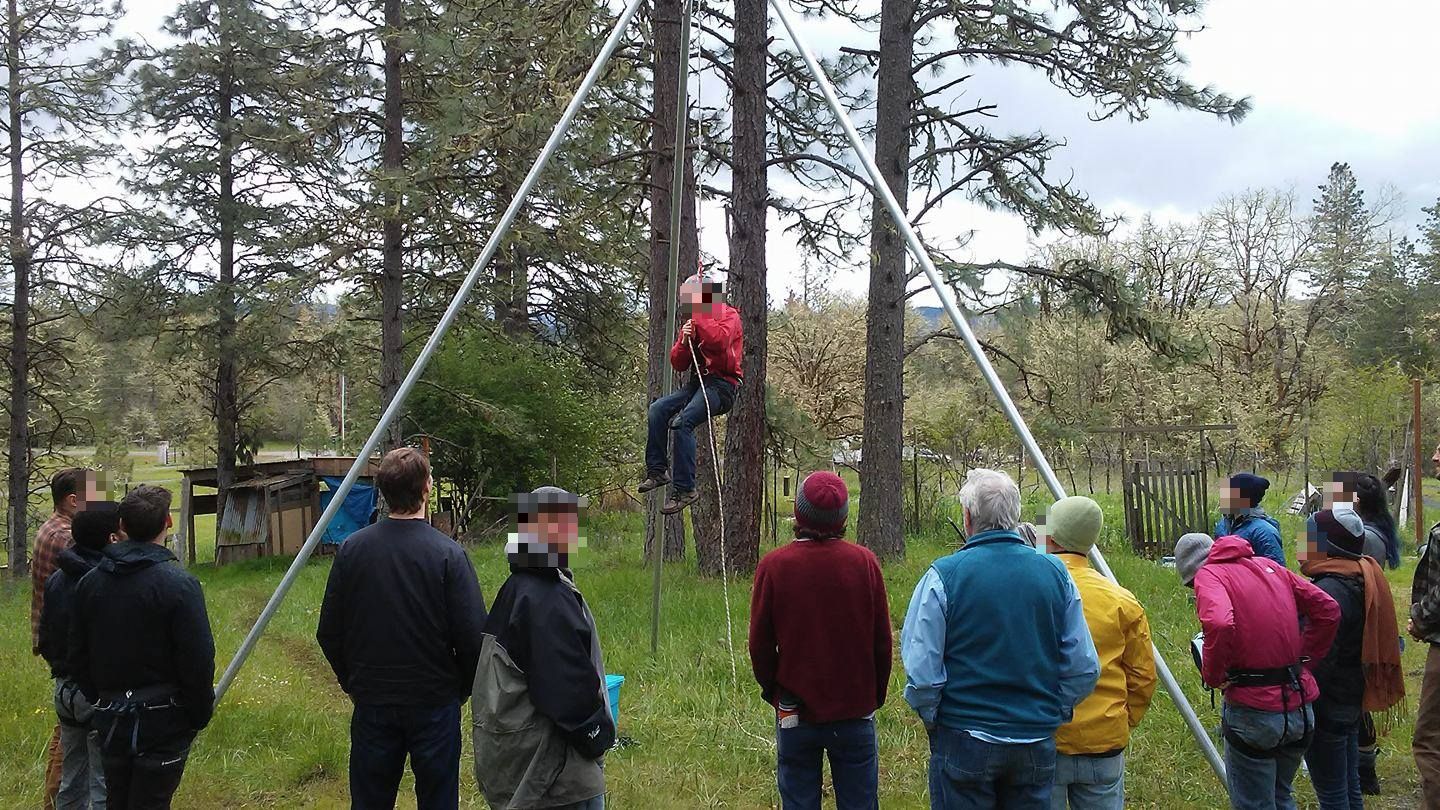
by DGR Editor | May 2, 2017 | Education
by Deep Green Resistance Eugene
Over Earth Day weekend, Deep Green Resistance members in Oregon hosted an advanced direct action training in rural western Oregon.
About 45 people attended from several surrounding states.
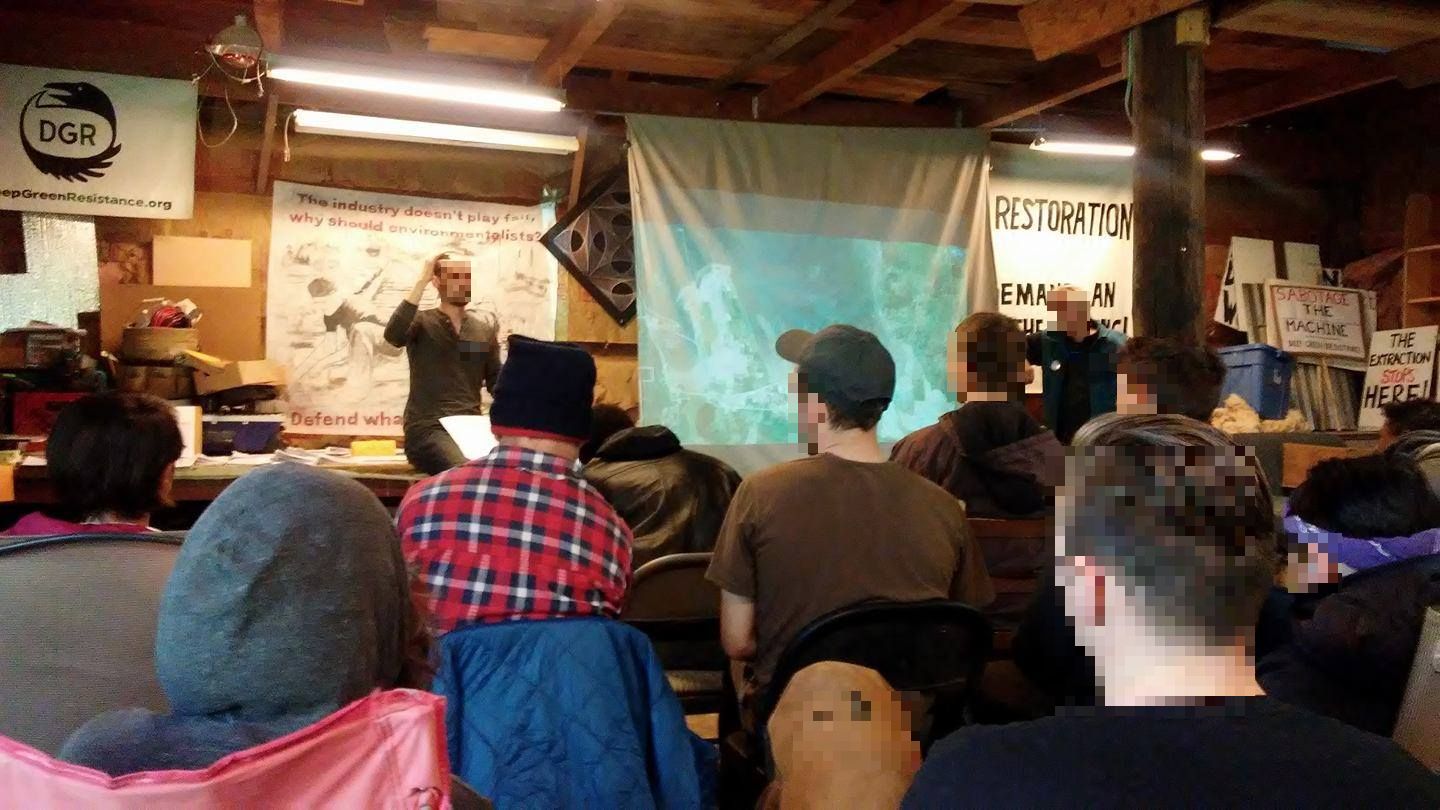
This workshop broke down critical factors and possible improvements for various recent and historical resistance actions and campaigns.
The training began with several anti-oppression sessions to help foster an equitable and safe environment for facilitators and participants, especially for people of color, women, indigenous people, and members of other oppressed and marginalized groups. These sessions, which included an introduction to radical feminism and a group activity around understanding privilege, aimed to inform the interpersonal dynamic and content of the training. This is also to help facilitate a more inclusive and comfortable organizing experience in our communities.
Other training sessions included:
• Campaign strategy
• Target selection
• Case studies in two recent direct actions from people involved in them
• Analysis of critical factors in other recent and historical resistance campaigns / actions
• Scouting for action
• Know your rights and legal briefing
• Art and resistance
• Media
• Various hard skills for blockades and direct action
• Communications and digital security
• Affinity groups
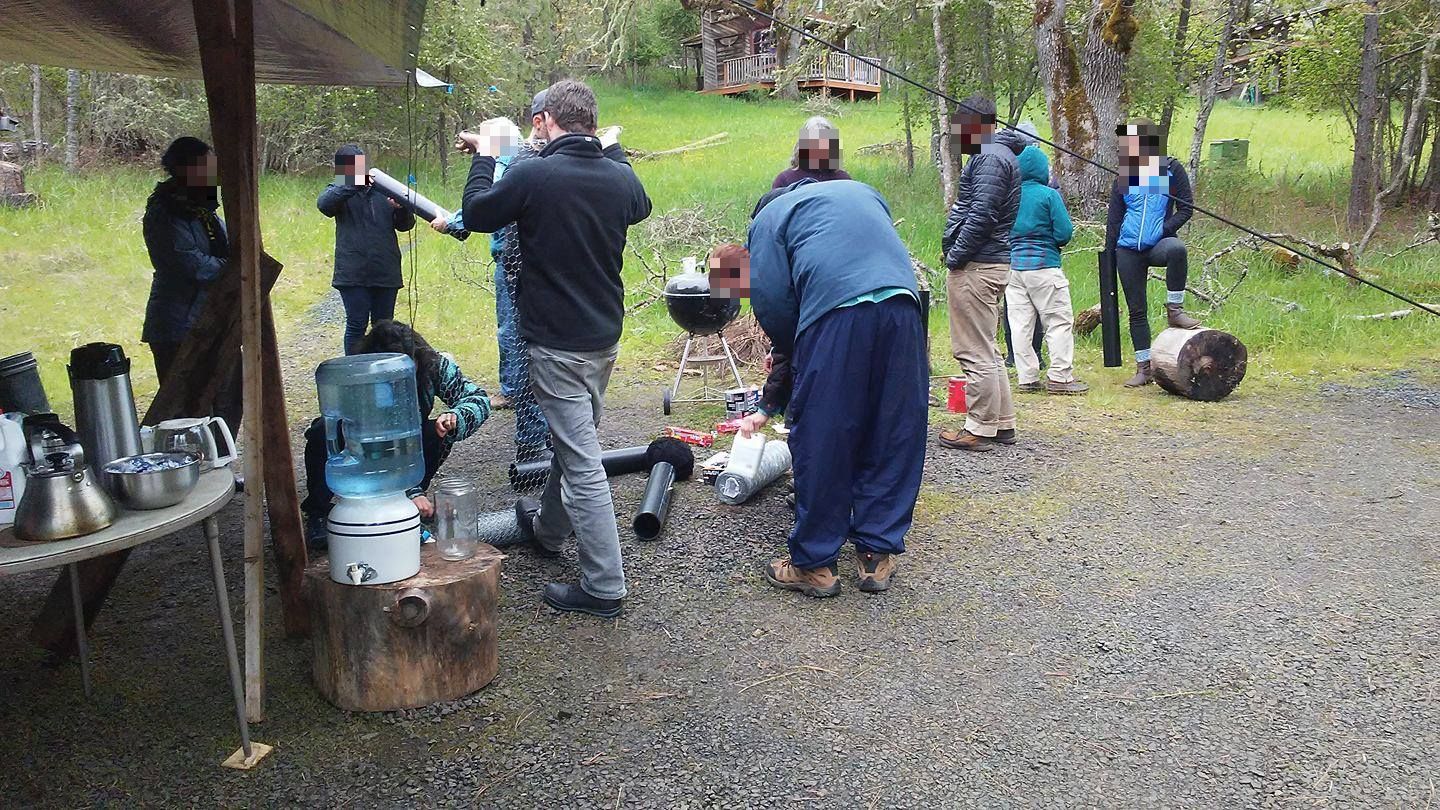
Experimentation with building materials for blockades.
Trainings like this play an important role in developing two critical elements in effective resistance: community and skills.
This sort of event would be impossible without financial support. To everyone who donates to Deep Green Resistance, is a monthly sustainer, or purchases gear from our website—thank you!
A few comments from attendees:
“Thank you… for such a comprehensive training in just a few days!”
“I considered not coming when I saw some militant photos on the DGR website, but I’m so glad I did. This training really debunked the myth of resistance activists being casually militant and violent people.”
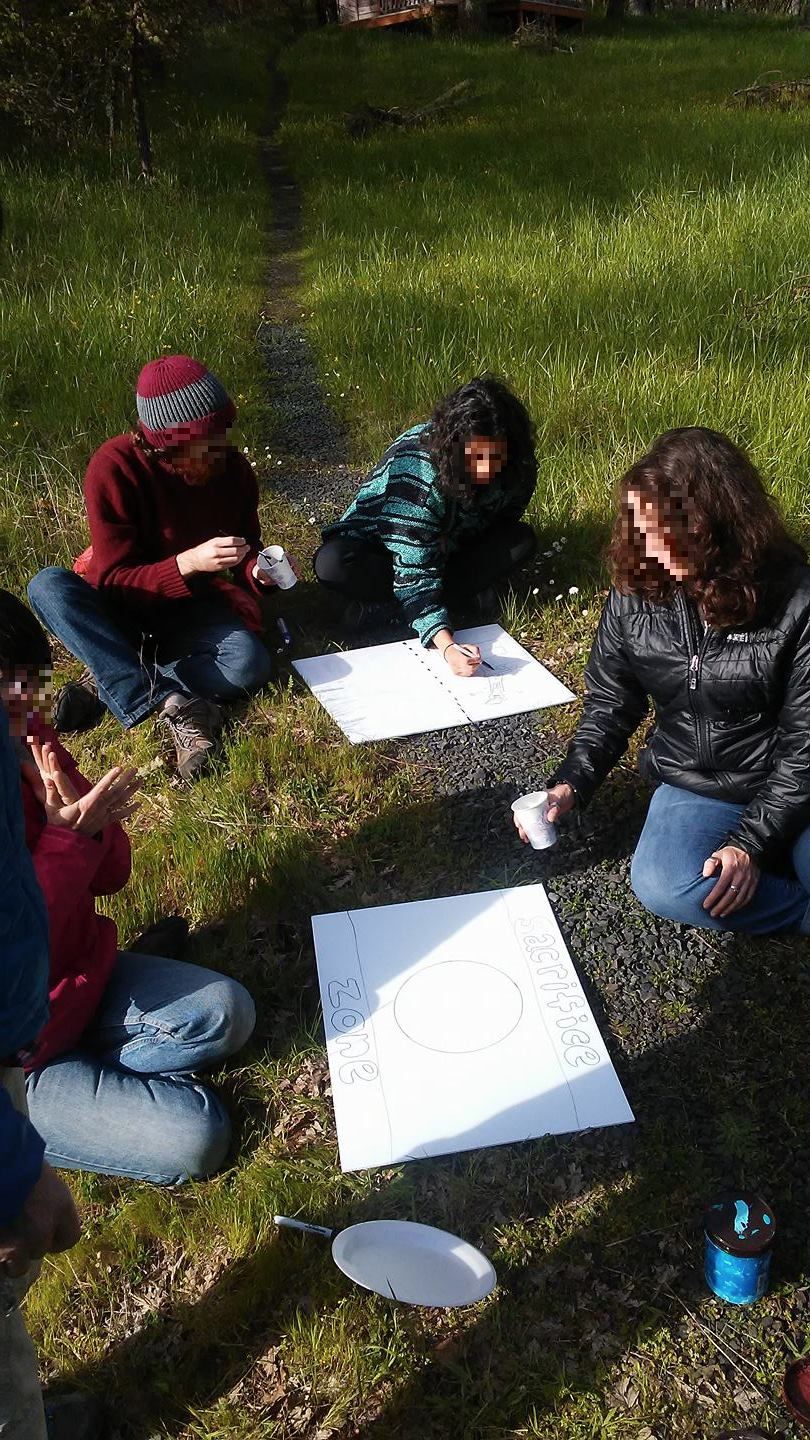
Artistic workshop after a long day sitting down inside.
“My daughter has been telling me for years about radical feminism and I never understood what she was talking about. I do now, somewhat, and I am aware of all I don’t know and hadn’t considered in terms of the climate crisis and potential steps I can take. I’m so glad I came.”
“I could spend weeks hearing and discussing the topics brought up on Saturday morning, and I learned a lot. The Privilege Walk was powerful and a great way to start the weekend. Thank you for the RadFem reading list and the matter-of-fact presentations on intersectional oppressions!”
“Awesome group of people at the training.”
“I’m home and full of inspiration… You have my deepest appreciation for the hours of hard work it took to make this weekend happen. The whole crew of you are simply wonderful, thank you for being dedicated enough to take bold actions and wise enough to do them prudently.”

Tripod and rope ascending workshop.
“The DA training offered an invaluable opportunity for DGR members and allies to meet in person, share ideas and skills, and build real community. Each new relationship felt like a door opening to our greater collective potential and previously unconsidered ideas. There is something magical in spending time together that cannot be quantified or explained. I can’t wait for the next get together and to see the inspiring ideas and actions that will surely come out of this training.”
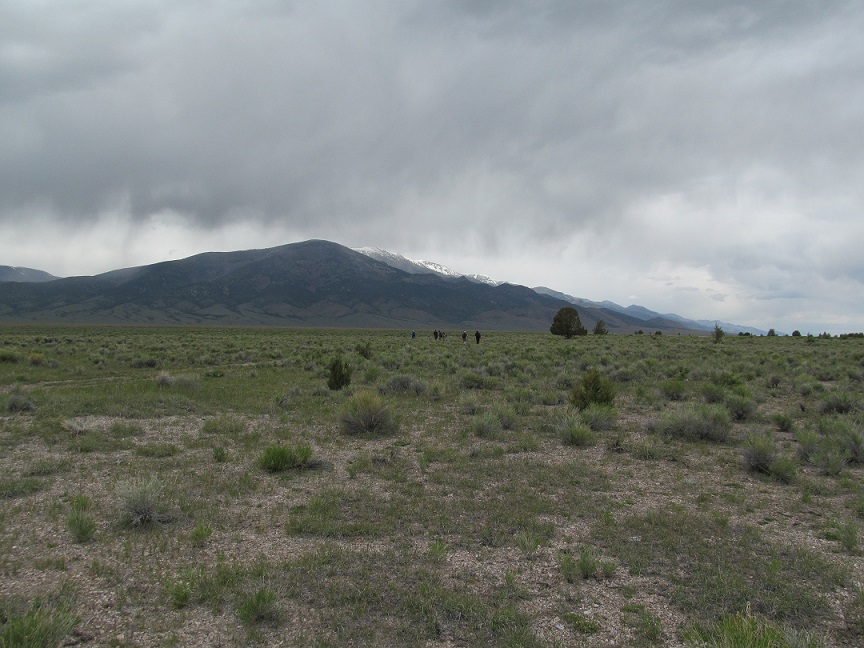
by Deep Green Resistance News Service | Apr 29, 2017 | Education
by Max Wilbert / Deep Green Resistance Great Basin
As a kid, I pictured Nevada as a wasteland of sand and cacti. Today, I know better.
For the past five years, I’ve been packing up my truck every spring and taking a long day to drive to eastern Nevada to bask in the glory of one of the least densely-populated areas of the United States.
The broad valleys never fail to stun me, but most amazing are the mountains, limestone peaks arcing into the sky. Springs and creeks flowing from the hills support rich riparian zones and bring in birds and other wildlife from miles around. Antelope, deer, elk, and wild horses cross the valleys or stick to forested patches. This region is lush, biodiverse, and beautiful.
It’s also under threat. Across eastern Nevada, the Southern Nevada Water Authority seeks to build dozens of massive groundwater wells and pump almost every drop of water south to feed Las Vegas developments. The project has been a battle between locals and developers from Vegas for decades, and still drags on.
Another major threat is felling pinyon pine and juniper forests across not just this region, but the entire intermountain west. Ranchers have been doing this for decades to remove pesky trees getting in the way of their grass—and more importantly, their profit. As overgrazing continues to desertify Nevada—it’ll look like Iraq in another 100 years—removing trees allows ranchers to maintain the illusion that overstocking can continue indefinitely.
Countless people, including myself, are mobilizing to fight like hell for this land, this water, and these forests. We aim to stop these destructive projects by exposing their true nature and—if necessary—standing in their way.
There is a lot more to these stories, but I don’t have time to share it all here. Instead, I’d like to invite you to join myself and other community members, indigenous people, activists, ecologists, photographers, and families for the fifth annual Sacred Water, Sacred Forests Camp.
The camp takes place over Memorial Day weekend, May 27 to 29, near the town of Ely and Great Basin National Park. If you’re interested in attending, you can RSVP on the Facebook event page or by emailing greatbasin@deepgreenresistance.org.
I hope to be able to introduce you to this important, imperiled area in a few weeks.
—
Max Wilbert is a community organizer based in western Oregon who considers Nevada a second home.

by Deep Green Resistance News Service | Feb 19, 2017 | Education, Movement Building & Support
by Erin Moberg / Deep Green Resistance Eugene
On Saturday, February 4th, several members of DGR Oregon attended a day-long NVDA training in Eugene, Oregon. The event was organized by local and regional activists. Over 200 people attended, including local activists, community members new to direct action, college students, youth, retired people, and others from nearby towns.
DGR members attended this training as part of an increased effort to connect with Eugenians from other activist groups and to invite community members to two upcoming events: (1) a DGR Open House in downtown Eugene (March 8) and (2) an Advanced Direct Action Training to be held just outside of Eugene over Earth Day weekend (April 22-23). We also, of course, wanted to see what we could learn.
The Keynote Speaker was Leonard Higgins, who shared a short film documenting his experience as one of the “valve turners” who shut down oil pipelines in five states in October of 2016. Higgins described direct action as “not the only important work to be done” but crucial in that it supports other activist work, including: changing the economy, transitioning to alternative energies, and expanding community organizing strategies. Although his remarks and the entire training focused on “preserving life as we know it and civilization” and “ensur[ing] a future for human civilization,” Higgins and the film did help to normalize and demystify direct action for those new to environmental activism.
People who want to support the valve turners can attend a legal costs fundraiser event on the evening of February 24th at 6:30pm at the First Methodist Church near downtown Eugene. The suggested donation for the event is $20, but no one will be turned away for lack of funds.
The workshops (Medic Training, Encryption Basics, Jail/Arrest Support, Action Planning, “Artivism,” and more) emphasized peaceful resistance toward the end of sustaining or bettering life for human beings. Even when referencing the Water Protectors at Standing Rock, there was no concrete mention of the destruction of the land and little reference to the occupation of indigenous communities and territories by the culture of empire. While this may be simple omission, it’s a trend in mainstream activist groups—especially in predominantly white groups—to avoid naming the problem, and to avoid being “negative.”
Most frustrating in the workshops was the lack of organization and structure; many facilitators had poor presentational skills, little understanding of key semantic nuances of relevant terminology (ie: violence, use of protective force, and violation), and an overall lack of consciousness around anti-oppression strategies necessary to foster equitable engagement and collaborative environments.
This is unsurprising, as in our experience mainstream activist groups and NGOs such as this often serve as a sort of buffer against truly revolutionary change by funneling energy, donations, and volunteers into minor reforms.
In the workshop on Action Planning, the facilitator (a Portland-based activist) did share several strategies that could be useful for DGR meetings, direct action trainings, and forum culture. One is the acronym WAIT/WAINT (Why Am I Talking? / Why Am I Not Talking?), a variant of the Step Up/Step Back framework designed to encourage those who occupy positions of privilege and tend to dominate (white people, men, documented folks, etc.) to hold space for those whose voices and experiences are often silenced or ignored (people of color, women, undocumented folks, etc.). She also explained the “Points of Intervention Model” as way for activists to identify how, where, and when to plan a concrete direct action. This model asks organizers to consider points of production (ie: labor site), destruction (ie: mines), consumption (ie: households), decision (ie: corporate head), assumption (ie: segregated spaces), and potential before then deciding on:
- vision –> (2) campaign–> (3) strategy–> (4) tactic–> (5) action
Her example was:
- Stop climate change–> (2) Halt proposed pipeline construction–> (3) pass anti-pipeline legislation–> (4) forums, petitions, lawsuits–> (5) Not specified during the workshop
While the training was a good first step for first-time activists interested in learning more about political organizing, this day of workshops didn’t provide a compelling vision of the application of political power. For those with little to no activist experience, there were no clear articulations of the history, potential, and goals of direct action. For those who attended as experienced activists, there were no hands-on workshops offered for specific direct action skills trainings (ie: how to build and use lockboxes). The legal presentations, encryption info, and medic training did offer concrete skills that are valuable to organizers. In terms of community representation at this event, there were no facilitators of color, few female facilitators, and few opportunities designed to connect training participants one-on-one.
Overall, this training focused on issues leading up to or arising in the aftermath of direct actions, not the actions themselves. For organizing large groups to achieve reforms, it was a potentially useful training. However, for people interested in deep revolutionary changes, it was lacking.
Thanks to the organizers for hosting this event.
People interested in learning more advanced skills should contact DGR Eugene to inquire about our advanced direct action training scheduled for Earth Day weekend, April 22-23.
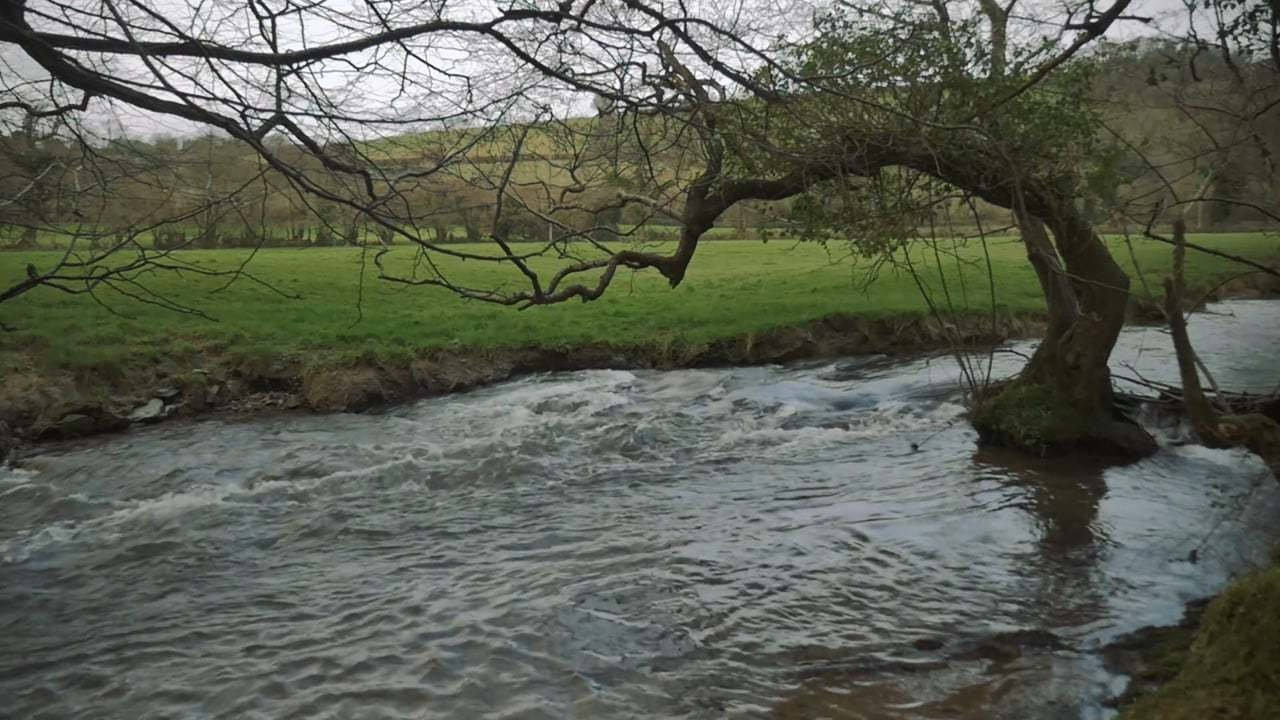
by Deep Green Resistance News Service | Aug 6, 2016 | Biodiversity & Habitat Destruction, Education, Lobbying
















